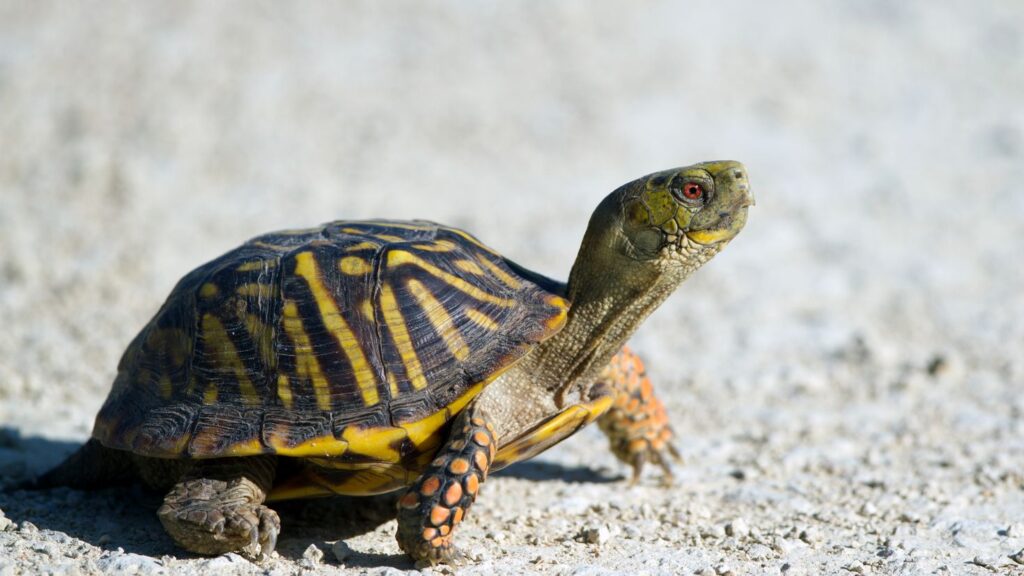Table of Contents
ToggleIntroduction
Red-eared slider turtles, scientifically known as Trachemys scripta elegans, have long captured the hearts of reptile enthusiasts worldwide. With their vivid looks, striking markings, and engaging personality, red-eared sliders are popular among pet owners. One common question in the context of their care is Can Red Eared Slider Turtles Eat Tomatoes? Lets explore

Understanding The Natural Diet Of Red-Eared Sliders
Examining their natural eating habits is crucial to comprehending the dietary requirements of red-eared sliders.
In their native habitats, red-eared sliders exhibit traits of opportunistic omnivores, consuming a varied diet that includes:
Aquatic Plants: Red-eared sliders feed on aquatic plants such as duckweed, water lettuce, and water hyacinth.
Protein Sources: Insects, worms, and aquatic invertebrates constitute essential protein sources for red-eared sliders, contributing to their growth and overall vitality.
Small Fish: These turtles may prey on small fish and tadpoles, adding an aquatic protein component to their diet.
Vegetation: Terrestrial plants found near the water, including grasses and fallen fruits, also find a place in the diet of red-eared sliders.
Nutritional Needs Of Red-Eared Sliders
Maintaining the health and well-being of red-eared sliders in captivity necessitates a diet that mirrors their natural eating patterns.
The following components contribute to a well-rounded diet:
Protein: Vital for shell development, muscle growth, and overall health, protein sources like insects, worms, and small amounts of fish are integral to the diet.
Vegetables: Dark, leafy greens such as kale, collard greens, and mustard greens are rich in essential vitamins and minerals, contributing to the overall nutritional balance.
Fruits: Limited amounts of fruits such as strawberries, melons, and bananas can offer natural sugars and additional nutrients.
Commercial Turtle Pellets: Specifically formulated to meet the nutritional requirements of red-eared sliders, commercial turtle pellets provide a convenient and balanced option.
Can Red-Eared Sliders Eat Tomatoes?
Whether red-eared sliders can assimilate tomatoes is greeted with a hearty yes, but it comes with certain limits.
Nutritional Content of Tomatoes:
High Water Content: Tomatoes boast a high water content, contributing to overall hydration. Adequate hydration is critical for the health of red-eared sliders.
Vitamins: Rich in essential vitamins such as vitamin C, which supports the immune system, and vitamin A, crucial for vision and skin health.
Antioxidants: Tomatoes contain antioxidants, including lycopene, associated with various health benefits.
Low in Protein: While tomatoes provide vitamins and antioxidants, they are relatively common in protein. Red-eared sliders require a balanced protein intake for shell and muscle development.
Considerations for Feeding Tomatoes to Red-Eared Sliders:
Moderation is Crucial: Tomatoes can be included in a varied diet but should not constitute the primary or exclusive food source. Moderation ensures a balanced nutritional profile.
Seed and Skin Removal: The seeds and skin of tomatoes contain compounds that may be less digestible for turtles. To mitigate any potential digestive issues, removing these parts before offering tomatoes is advisable.
Variety in Diet: A diverse diet ensures that red-eared sliders receive a broad spectrum of nutrients. Tomatoes can be integrated into this varied diet.
Observation is Key: While some red-eared sliders may readily consume tomatoes, others may show less interest. Observing their response to this food helps ensure it complements their diet.
Risks And Considerations
Even though giving red-eared sliders vegetables is good for them nutritionally, it’s important to know about the risks and other things that could go wrong.
Oxalic Acid Content: Tomatoes contain oxalic acid, especially the green parts. This compound can interfere with calcium absorption in high amounts, which is crucial for shell health.
Individual Sensitivities: Individual turtles may exhibit different sensitivities or allergies to certain foods. Any observed adverse reactions, such as changes in behavior or digestion, should prompt consultation with a reptile veterinarian.
Avoid Processed or Seasoned Tomatoes: Processed or seasoned tomatoes, as found in sauces or salsas, should be avoided. These products may contain additives, preservatives, or high salt levels, which can harm red-eared sliders.
Crafting A Balanced Diet

For red-eared sliders’ optimal health, it’s best to design a diet that includes a variety of foods.
The following serves as a general guideline for a balanced diet:
50-75% Dark, Leafy Greens: A mix of kale, collard greens, mustard greens, and other nutrient-rich leafy greens.
20-30% Vegetables: Various vegetables, including carrots, squash, bell peppers, etc.
10% Fruits: Limited fruits like strawberries, melons, and bananas.
10-15% Protein: Protein sources such as insects, worms, and, in moderation, small amounts of fish.
Commercial Turtle Pellets: If you want to make sure your turtle gets all the nutrients it needs, supplement its food with high-quality commercial turtle pellets.
Conclusion
While tomatoes offer certain nutritional benefits, they should not become the primary or exclusive food source for red-eared sliders. A well-balanced diet that includes a variety of dark, leafy greens, vegetables, and appropriate protein sources such as insects and commercial turtle pellets remains essential for their overall health and vitality.
As responsible caretakers, observation of the turtle response to tomatoes, coupled with a diverse and thoughtful approach to their diet, ensures that red-eared sliders thrive in captivity. Consulting with a reptile veterinarian for personalized dietary advice can further contribute to the well-being of these captivating aquatic companions. In the world of red-eared sliders and tomatoes, balance and careful consideration pave the way for a healthy and happy life for these remarkable reptiles.







